There’s a reason B2B companies are spending 55% of their annual marketing budget on content production and creation.
It works!
70% of people would rather learn about products through content, and 68% of consumers spend time reading content from a brand they’re interested in.
How To Create A Content Marketing Strategy That Succeeds
As the old content marketing saying goes “If you create a piece of content but nobody reads it, does it even exist?”

In order to develop a successful content strategy you need to know the following:
- What topics do my audience love?
- Who will promote it?
- Who will publish it?
But Ben, this sounds like a lot of work…..
Don’t worry, there are tools that will help us answer each of these questions!
I will be using Ahrefs to help us find the sweet spot of where we make great content that people will want to promote and share for us!
If you have access to BuzzSumo you can follow the same steps, I just like the backlink data from Ahrefs better.
How To Find Content Topics Your Audience With Love!
1. Pick your top keywords
Spend a couple of minutes listing down the main topics you would like people to discover your website for. Let’s use Sumo as an example.
Looking at their homepage, I would guess that keywords around “website growth” & “traffic” are a high priority.

2. Find what is popular around the topic
Now go over to Ahrefs and use their Content Explorer tool for the main term you listed down.
If you are not familiar with Ahrefs Content Explore, what it does is find the most popular content on a specific term.
It does this by looking at the following key points:
- Domain Rating: Similar to Moz’s domain authority, this is how Ahrefs judges the authority of the website
- Referring Domains: How many other people are linking to that post
- Social Shares: Total shares across the major social networks
- Median Shares: Represents the midpoint for all of the social channels

Looking at the term “website traffic” there is a ton of content that has been produced. Depending on your results you can filter by how old the content is. I usually filter it by the past year.
Now, export all of the data and put it into an Excel spreadsheet or Google Doc:
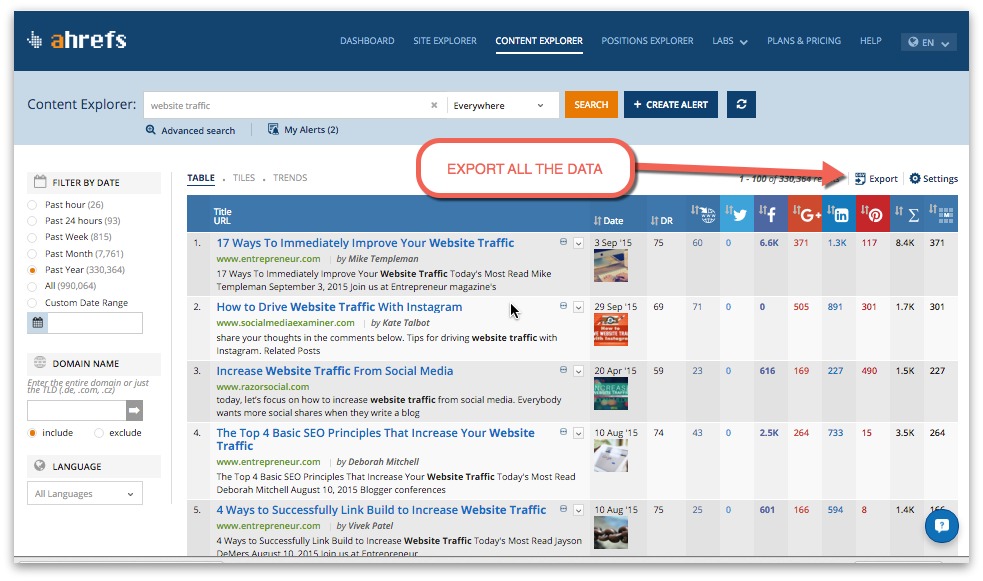
3. Get All The Data
Rinse & repeat what you did in step 2 for each of the main terms that people might find you by.
For Sumo it could be for terms like “Wordpress plugins for business”, “tools to get more traffic,” “social sharing buttons,” “grow your email list,” etc.
Find the top content for each of these terms and export them from Ahrefs.
If the terms are similar you can put them in the same tab, but if they are different subjects I recommend putting them into different tabs.
With Sumo, I would divide the tabs by Traffic, WordPress, and Business content:
.
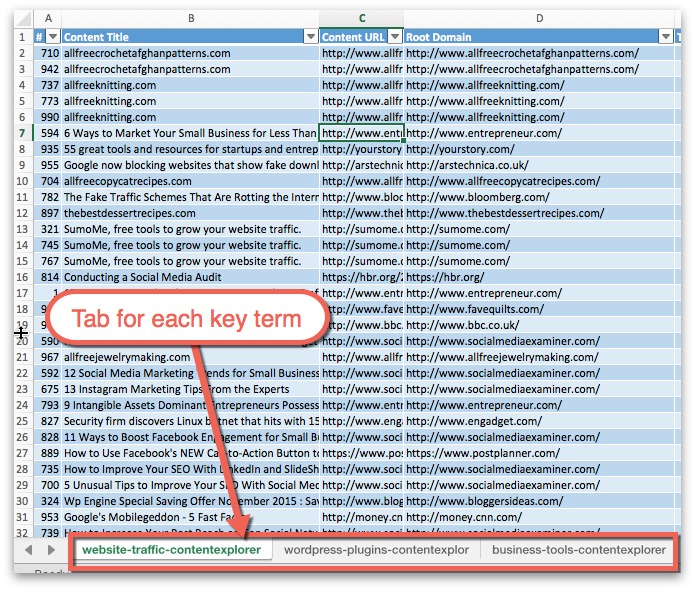
4. Find Themes In the Data
Visualizing Key Terms
The first thing to do is to grab all of the “Content Titles” and put them into a word cloud to find any trends. I like to use Tag Crowd or Jason Davies Word Cloud depending on how much data I’m working with.
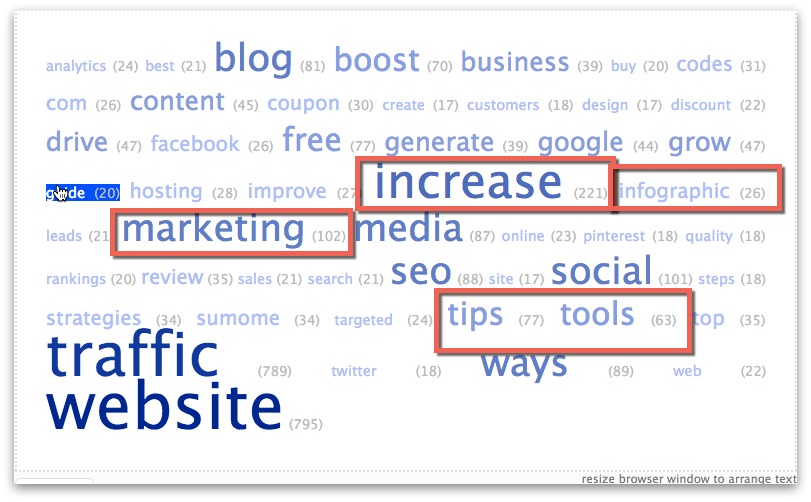
Content Research = Done!
Just from this word cloud, I can see that people who are looking for “website traffic” are interested in tips, tools, and ways to increase their website traffic.
I also now have a list of resources for the top tips, tools, and even infographics on the topic. All I have to do is filter the content title results by “tips” and have the most popular list posts on the topic!

When To Publish
When you export from Ahrefs it gives you the exact date that the content was published. If you take the publication dates and chart them by month you can see if the topic has some seasonality.
If you are able to find a seasonal trend around your topic you will know which months and events are best for your content where you will get more coverage.
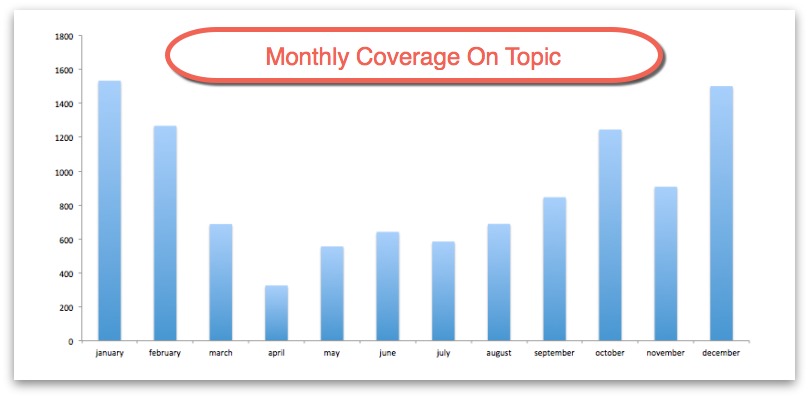
PRO TIP! Be sure to check out peak months to see if it is something seasonal that you can plan to target like holidays, the Super Bowl, winter etc OR just a hot topic that happened that year and will not repeat every year such as political elections (don’t get me started with Trump) or when a famous celebrity passes away.
5.Decide On What Topic To Cover
After looking through the data, you will start to see trends of what topics and content work around your niche.
You will also see where the bar is set for content and what you will have to do to contend with those who are successful!
For example this blog post on Bloomberg “How Much Of Your Audience Is Fake” has 10K social shares and 650+ links pointing to it!

It may just be because they are Bloomberg OR maybe because the blog post has all of the following in it:
- Animated gif headings
- A video
- Infographic
- Smaller data graphics
This is who you have to compete with!
So take a good look at what you’ve seen that has had successful and you are confident that you can do it better and go after it!
Creating A Promotional Hit List
In the first section we talked about picking the right topic and content to create. While you are getting the content ready you should also spend some time getting to know who will promote and publish your content ahead of time.
1. Setting Up Your Spreadsheet (Excel or Google Spreadsheets)
Before our next steps, we need to add a couple of columns to your spreadsheet.
First: Root Domain Column – We want to see what the main website for each of the articles is. This alone is not very helpful, but just wait.
Formula To Use – =LEFT([@url],SEARCH(“/”,[@url],9))
Second: Times Covered Column (For Root Domains)– Now that we know what the root domain is, we can count how many times that domain covers the topic.
Formula To Use – CountIF(Range, Criteria)
Third: Author Count Column – Just like the Root Domains column. Create a new column next to authors to count how often an author has written on the subject.
Formula To Use – CountIF(Range, Criteria)

After you get these columns set up make sure to organize them in the following way:
- Root Domains – Ascending
- Author Name – Ascending
- Author Count – Descending
- Times Covered – Descending
2. Find Authors Who Write For Several Sites
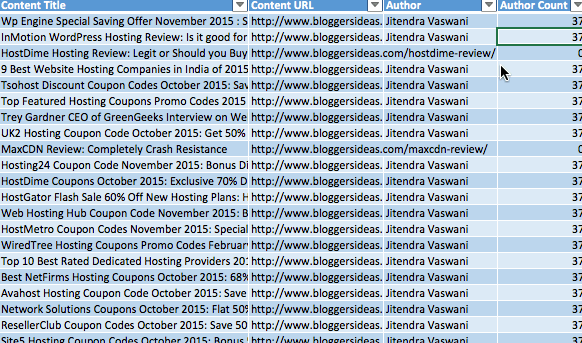
You could try to write for each publication yourself OR you could hit up the authors who already do to see if they would be interested in covering your content. If they had a successful article in the past they are likely to do it again.
Getting your content published on a single site is awesome, but what if you could get someone to publish you on several sites!? Even better right?
If you filter your list by the amount of times an author is mentioned you can find when an author writes for several publications on the topic!
Like in this example where Pam Moore has written about website traffic for 3 different publications! She would be a great person to connect with, aside from being a great marketer, because if she likes your content she might include it on several different websites next time she blogs on the topic.
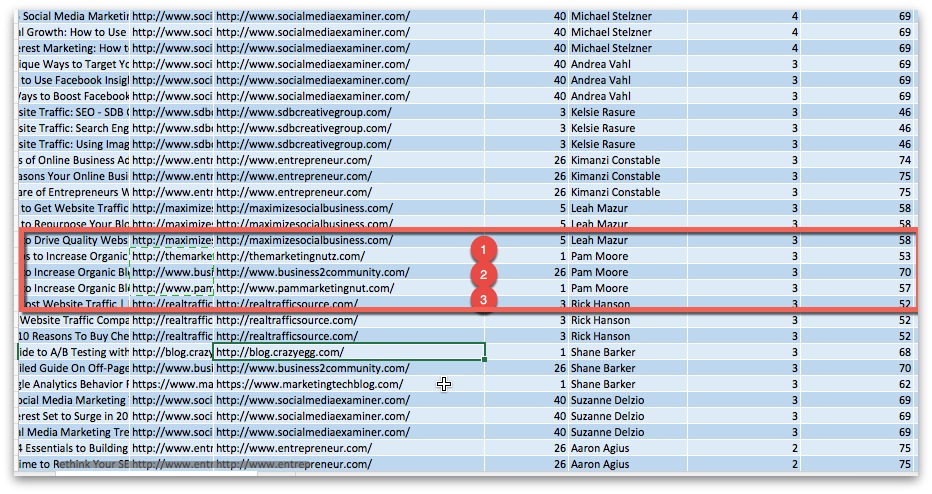
3. Find Domains With Lots Of Authors
Go to the times covered column and filter by descending to see which root domains talks about your key term the most. The more times they cover the topic the more likely they are to cover it again.
Look at Entrepreneur.com for example, it had 26 posts in the last year about “website traffic” from nearly 20 authors!
Again it is a lot easier to work with someone who already posts on the publication you are looking at. Check out the authors who cover the topic the most and see what they are writing about. See how they cover the topic and how you could potentially work with them.
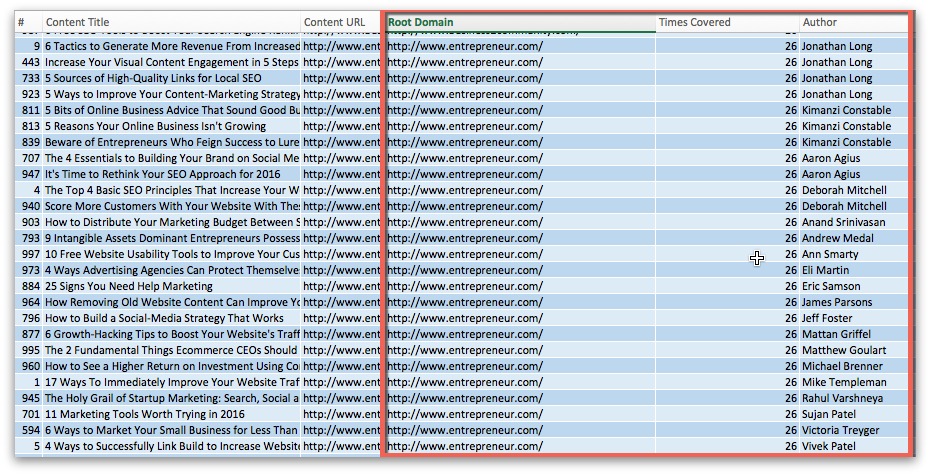
4. Pitching Authors & Journalists
Just having “The Perfect Topic” will only get you so far. Anything you can do to make the author's job easier and look good will greatly increases the likelihood of them using your content in their next article.
Breaking The Ice
Before I even pitch an author I like to engage with them online first so they at least know who I am. Some of the activities I do are:
- Follow them on Twitter
- Reply to a tweet from them
- Comment on a blog post of theirs
Ready To Pitch Your Content
Once your content is ready it is time to start pitching it to your hit list of authors:
Ross Hudgens increased his agencies success rate with blogger outreach by 63% by following these simple rules:
- Make part of your content easily embeddable like infographics, images, videos, or unique data statistics.
- Ask the blogger if they are interested before sending them your content. This drastically improves the likelihood that they will cover you.
- Create custom intros – 48% of the bloggers used their agencies custom post intros.
- Follow up on your pitch – people get busy & forget! Make sure to follow up.
Here are the outreach templates that they use at Siege Media.
First email:
Subject: [CONTENT TYPE] for [WEBSITE]
Hi [NAME], We created a [CONTENT DESCRIPTION]. We thought you’d be interested at [WEBSITE] because [REASON].
Let me know if you’re interested in seeing it and I’d be happy to forward along!
[Signature]
Note :the reason could be a reference to the successful blog post they have done before on the topic.
Second email if recipient is interested:
Hi [NAME]!
Thanks for the reply, you can check it out here: [LINK]
If you decide to share it on your site, I’d be happy to write a custom intro to the post for you.
Looking forward to your feedback!
[Signature]
Find Who Will Publish
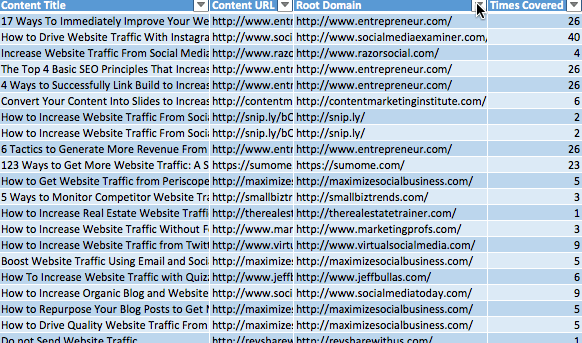
After you’ve talked with as many authors as you can maybe you want to try doing your guest posting yourself OR a lot less work is to get major websites to re-publish your content!
Sarah Peterson did a great post on how to get published in major publications so definitely recommend you read her entire guide!
In short though, you can filter the Root Domain column by Times Covered again and you can go through and start pitching the publication editors.
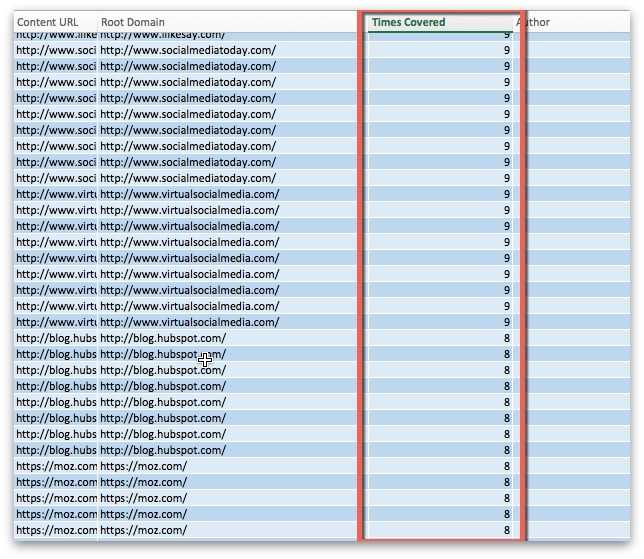
Here is Sarah’s Email Template To Get Editors To Republish Your Content
Subject: Use the Sumo Kickass Headline Generator
“Hi [Editor name],
[Personal connection point]
I recently wrote an article about [topic] which my audience has enjoyed. I think [publication name’s] audience would love the article as well, because [why?].
I’ve included the article in the body of this email below, and if you’d rather check the original article out here is the link:
[link].
If you enjoy the article and think it would be a good fit, I would love to have it republished on [publication name].
Let me know what you think.
[Your name]”
Stop Wasting Time On Bad Content
Content marketing can be extremely powerful when done correctly.
This process we just went over can be used again and again.
The best part, with every piece of amazing content you publish, you establish yourself in your field and makes it easier to work with authors and publications.
Don’t just take my word for it. Try this out!
- Start with doing the research to find a topic that your audience is crazy about.
- Create a hit list of authors & publications who cover your topic a lot.
- Start engaging with authors and influencers who could promote your content
- When the content is ready, reach out to the people & publications from your hit list
- Enjoy success and repeat
Add A Comment
VIEW THE COMMENTS